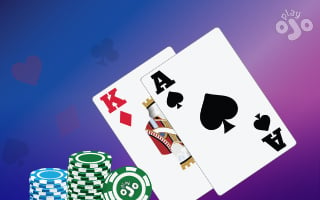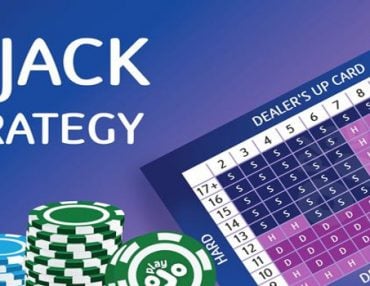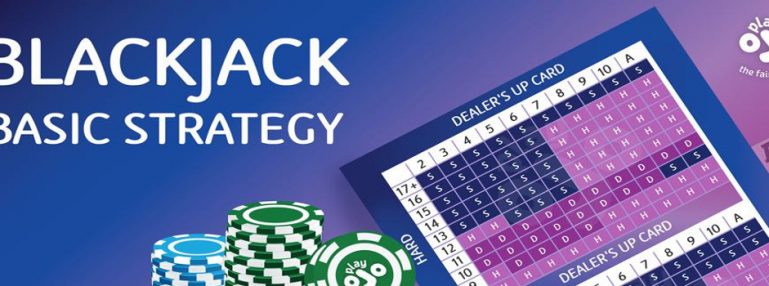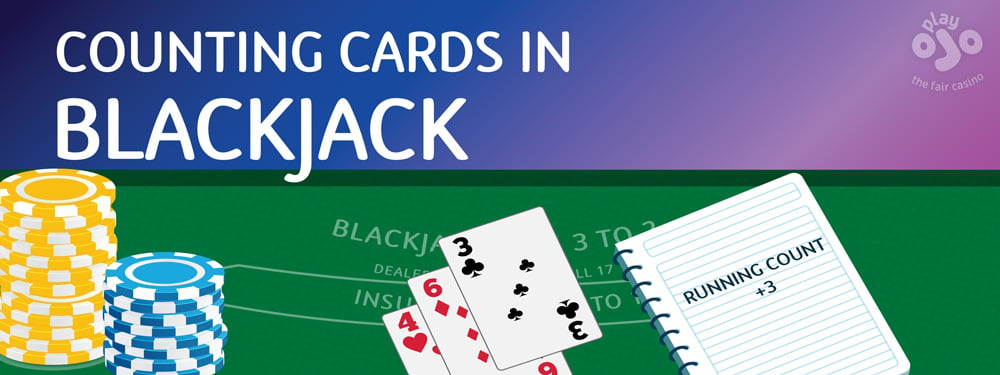
There probably isn’t a casino player alive who hasn’t thought about learning how to count cards at blackjack.
This famous advantage play gained notoriety in America once brilliant mathematicians discovered you could turn the tables on casinos by tracking which cards had been dealt and which were left in the deck. But there’s more to mastering how to count cards in blackjack than tracking the cards, as you’ll discover in this guide.
From how to keep a count to how much to bet and how to keep your skills on the down-lo, we’ll reveal the secrets to the world’s most famous casino game skill.
What is card counting?
Once you’ve learned the rules of blackjack, then mastered basic strategy, you might be tempted to learn how to count cards in blackjack.
Counting cards is the stuff of blackjack folklore and although it’s more of an intellectual challenge than a way to make a living these days, counting cards still has the potential to eliminate the house edge.
Card counting gives you a better idea of which cards are left in the deck, and how to use that info to your advantage.
A deck full of higher value cards is good for players, as it’s easier to make Blackjack. A deck rich in lower value cards is bad for players.
When you know if a deck has become better or worse, you can increase or decrease your bet size, and make some alternative strategy decisions too.
Fortunately for players looking to learn how to card count in blackjack, you won’t need to memorise every card that’s dealt. Card counting methods assigns a point value to each card, so you can keep a running tally.
With the ideal combination of table rules, a player who accurately counts cards can gain a 2-4% edge over the house in a game that normally has a 0.50% advantage for the casino.
But before you invest your time and money into a career in card counting, you should know that this method works best in single-deck games which are rare. Also, land-based casinos are always on the look-out for experienced counters, so the chances are you won’t have much time to cash in before they ask you to leave.
How does it work?
In blackjack, players at the table will see several hands before the deck is shuffled. Once part of the deck has been dealt, it’s possible to calculate what’s left in the deck.
In the simplest terms, if you know that no more Aces are left in the deck, it’s impossible to make Blackjack and the smart play is to pack up and leave. A deck with fewer cards worth 10 will also increase the house edge, as it’s harder to make Blackjack, harder to make high hands like 20, and the dealer busts less often.
On the flipside, a deck with fewer Sixes lowers the house edge. This is partly because you make fewer weak starting hands, and because the deck is now stacked with bigger cards. The dealer will bust more often too.
In common card counting systems, each card is assigned a positive, negative or neutral value , depending on the effect its removal has on the rest of the game. In most systems, Aces and cards worth 10 (Kings, Queens, Jacks and Tens) are negative, 2s to 6s are positive and the rest are neutral.
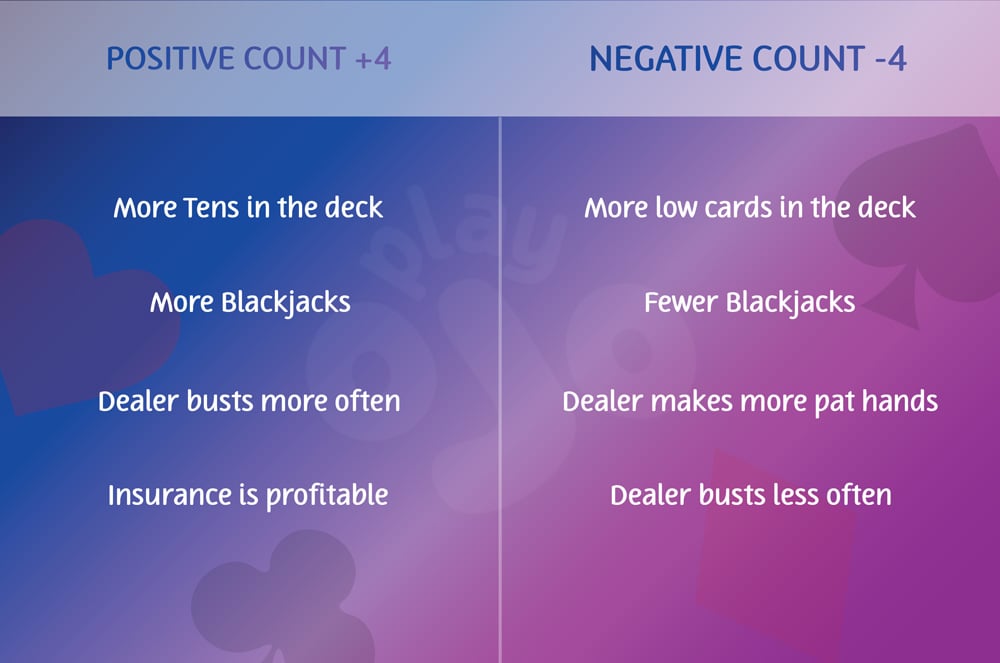
A positive count tells us that more low cards have been removed and fewer are left in the deck. This means the rest of the deck is rich in high cards which are more valuable to the player. A negative count happens when more high cards have been dealt, leaving a deck full of low cards which are of more use to the house.
How to count cards
Assuming you already know how to play blackjack and have your blackjack basic strategy nailed down, card counting involves 4 steps, all of which are critical in if you’re to get any benefit from a blackjack counting system.
Step 1: Decide what each card is worth
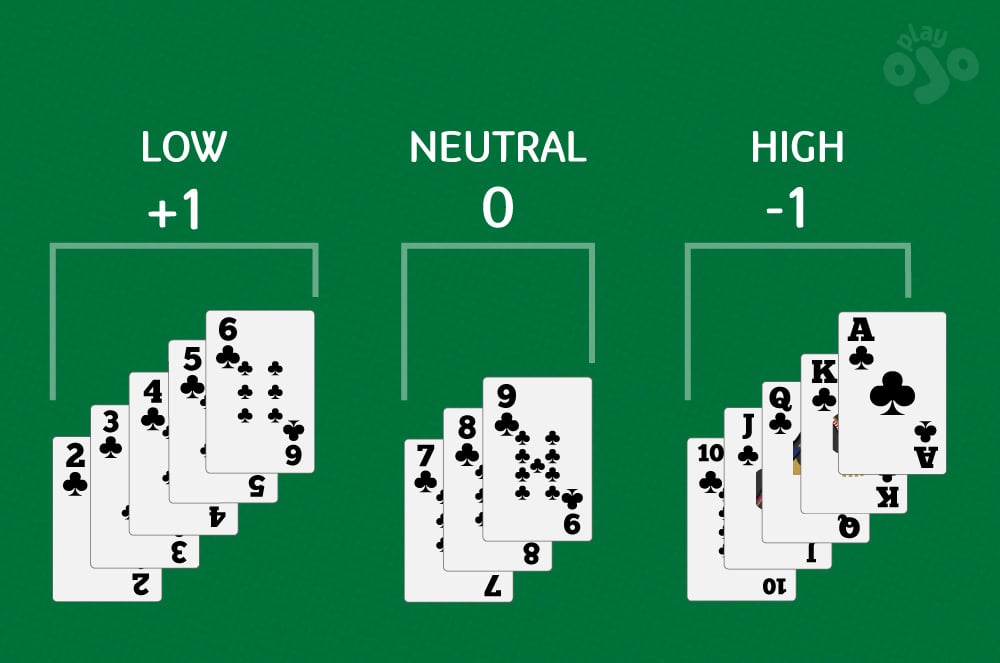
All card counting systems give a points value to each card in the deck. Remember, suits mean nothing in blackjack so it’s the fundamental value of the card (e.g. a Jack is worth 10) that matters . Here’s the points model for the most popular card counting system.
Step 2: Keep a running count

The running count is the cumulative total of cards values. The count always starts at zero after the deck is shuffled.
In the example above, you can see a sequence of cards dealt at a blackjack table, the card count value for each card and the running count, which ends in a final count of -1.
Keeping an accurate running count is the most important skill in card counting. With enough practice in a live casino environment, it should become second nature. Players often count cards in pairs, to speed up the process.
As well as recognising that K-Q is worth 20, counters will instantly know that the hand is worth -2 to their running count. Hands that feature one high and one low card cancel each other out and can quickly be ignored.
Step 3: Calculate the true count
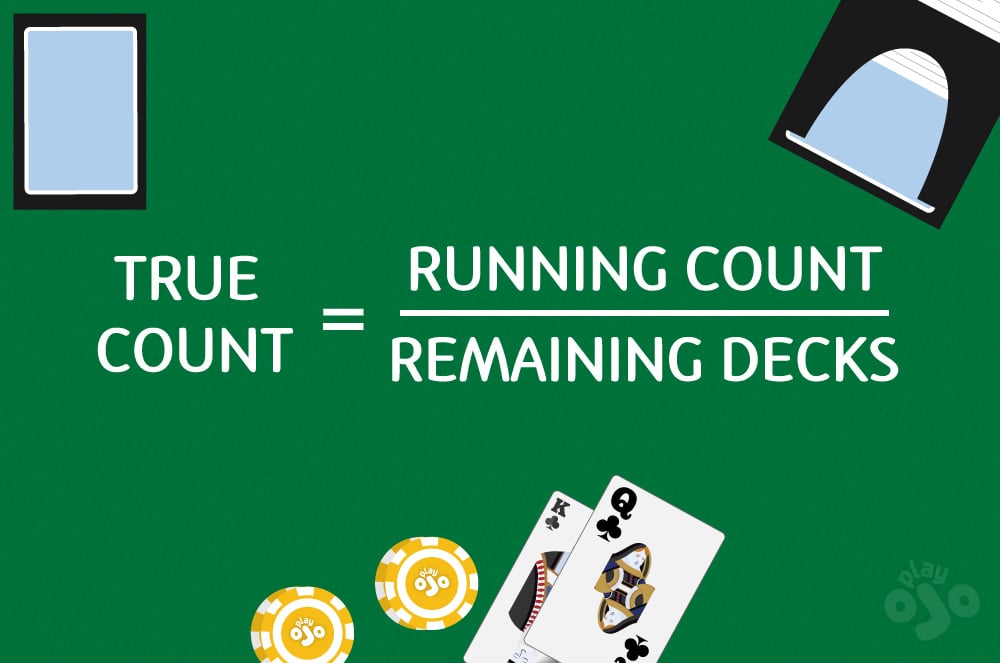
In a single-deck game, the running count is all you need to determine whether to bet big or small. But if you’re playing a game which uses multiple decks, you have to divide the running count by the number of decks remaining in the shoe .
To find out the true count, you need to know:
- How many decks are in use?
- What’s the running count?
- How many decks have been dealt and how many are left?
Take an 8-deck game where the running count is -3 and there are 6 decks left in the shoe. Here’s how we calculate the true count:
-3 divided by 6 = -0.5
How do you know how many decks are left in the shoe? A quick look at the discarded cards will tell you roughly how many decks have been dealt (to the nearest full or half deck). Unlike the more mathematical and clear cut elements of card counting, this part comes down to experience.
Step 4: Choose your bet size

Changing your bet size is the cornerstone of card counting, as your bet size should be related to the count. Bet big when the deck is in your favour, and smaller when it favours the house. You won’t see a high true count very often, so it’s vital that you take advantage when it happens. That usually means betting the maximum that your bankroll management rules allow.
- If the count is zero: Make your ‘unit’ bet size (for example, 1% of the total chips in front of you).
- If the count is negative, either reduce your stake, sit out the hand or move tables.
- If the count is positive, bet more units. The higher the count, the more units you bet. The range of bet sizes is called the ‘spread’, and can include as few as 4 points or as many as 15 points. Many systems will recommend a maximum bet of 4 times your unit bet, while other common betting strategies involve subtracting 1 from the true count and multiplying the resulting number by your unit bet.
For example, if the true count is +6 and your unit bet is £10, you should bet £50.
Ensure you have enough chips to cover a long run of bad luck, and prevent emotion creeping in. Not having the funds or the courage to place a maximum bet when the count is high is one of the worst mistakes a counter can make.
Step 5: Adapt your basic strategy

Betting big or small depending on the true count is the first step towards card counting success. If you want to go the whole hog, you’ll need to tailor some of your mid-hand decisions too. In general, counting strategy changes fit into one of several categories.
- For a high count of +3 or more:
- Take insurance
- Stand on 15 and 16 against a 10
- Double down more aggressively
- Splitting pairs such as Tens which would normally stand
- For a low count of -3 or more:
- Double less often in marginal situations
- Hit hands such as 12 against a 6 which would normally stand
Step 6: Disguise your play

Effective card counting is not just about betting more when the deck is good, and less or nothing at all when the deck is bad. You need to execute your strategy without alerting the casino. If you are asked to leave just as the deck gets good, you’ve wasted your time, energy and possibly money.
There are several tricks to ensure you fly under the radar:
- Be inconspicuous. Play the role of a classic recreational blackjack. How? Try not to study the cards or look like you’re at work. Play side bets even though the odds are not in your favour. Dress down and leave the Rolex at home. Order a stiff drink, even if you don’t drink it.
- Avoid classic counting tells. Don’t join midway through a shoe or leave once the count goes negative. Don’t split Tens! Sit in the middle of the table rather than 1st or 3rd base.
- Bet conservatively. If you want to visit the same casino again, it’s better to play more hands at lower stakes than hit the casino for high stakes.
- Limit your spread. A 15 point spread means you will be betting 1 unit when the deck is unfavourable and a whopping 15 units when the deck is perfectly packed with Tens. A 5 point spread with a 5 unit maximum will draw less attention.
- Randomize your play . Casinos are experts in spotting smart blackjack play and betting strategies, and they may also know the true count too. Throwing in some random decisions and bet sizes, even if it cuts into your profit, can help to throw them off your scent.
- Mix up your gaming. Playing keno or slots on your way into or out of the casino can build your image as a recreational gambler.
My top card counting tips
When Thorp first revealed his basic strategy and card counting method, the conditions were perfect for anyone to try their hand at beating the game. Almost 60 years later, the blackjack landscape has evolved and the casinos are smarter at protecting their profits.
It is still possible to find a game where card counting can reap rewards, but this advantage play comes with a number of caveats.
- Prepare for a grind
It will take time, effort and perfect execution to reap any rewards. As a card counter, you need to do many things at once; Keep a running count of all cards on the table, play your own hand using basic strategy, follow a bet size strategy and occasionally deviate from your basic strategy. All this while disguising what you’re doing!
Although anyone can learn the basics of card counting, pulling it off is both physically and mentally challenging, and ultimately far less glamorous than it sounds! - Scout for the best rules
Find the right table rules for your card counting blackjack game. Counting cards is about as useful as a chocolate teapot if you’re playing a game with a continuous shuffling machine.
Look for a set of rules which matches the system you’ve learned. If you’re intending to play lots of blackjack today, it makes sense to be picky about what table you choose, and how long you play. - Play perfect strategy
Choosing the right strategy is crucial when you count cards. Counting cards perfectly can reduce the house edge or even gain an edge over the house. But inaccurate counting could lead to even worse losses than if you weren’t counting at all!
That may be the reason why, far from fearing the waves of new counters after the release of Thorp’s seminal book, Las Vegas casinos were believed to have welcomed amateur counters.
A profitable high count will only occur between 15-35% of the time, and casinos are now wise to the ways of the card counter, so any edge you gain will be small or non-existent. - Cover your tracks
To count cards well, you need to fly under the radar using an effective ‘cover’, as counters call it. If you can’t play the part of a regular gambler while counting accurately, you might as well hit the road.
If you’re lucky enough to find a great game, you don’t want to alert the casino before you’ve made a single dime. Counting cards in blackjack should be an automatic process, and much of the skill comes in how you avoid attracting attention.
If you can play the part of a happy-go-lucky gambler who likes to split Tens every now and then, you’ll get a warmer welcome and a weightier wallet! - Watch where you sit
Pick your seat carefully. Sitting in seat 1 (the first seat on the left from the player’s perspective, but the furthest from the dealer in the order of play) is far better than sitting in seat 7.
As the last player to act, you get to see more cards which gives you a more accurate count. - The more hands, the better
By being involved in more of the action at the table, you can control the speed of play and the number of cards that come out.
In some very unusual circumstances, expert card counters have sacrificed one hand to learn more about the deck, which they use in their other hand. - Don’t count cards online
Live Blackjack tables aside, the internet isn’t the right place to practice a card counting blackjack game. These systems are useless when you play classic online blackjack in an online casino because the desk is shuffled every hand by a random number generator.
You’re ready to count!
So that’s blackjack card counting, amigo! If you want to know how to win at blackjack , counting cards is one of the most important skills to learn, and it’ll keep your grey cells in tip-top shape too. Good luck!





